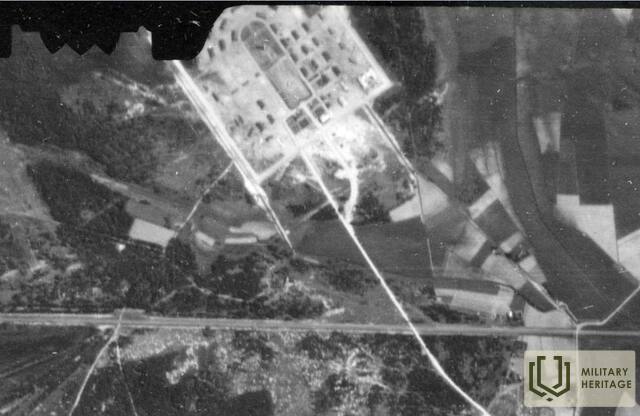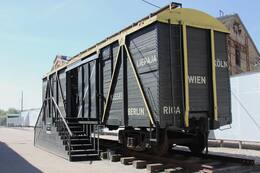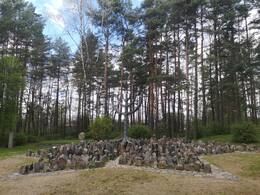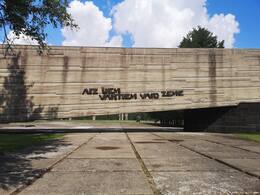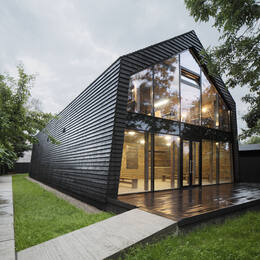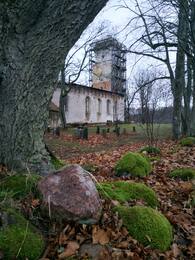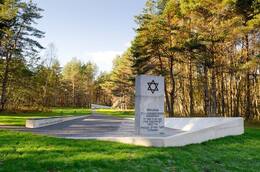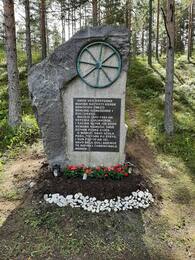Koncentracijos stovykla
I WW1, I Nepriklausomybės karai, Baltijos šalių nepriklausomybė, II WW2, IV Sovietų okupacija
Koncentracijos stovykla – uždaras ir saugomas, po atviru dangumi esantis sulaikymo kompleksas, skirtas didelėms žmonių masėms izoliuoti – uždarų ir nuo išorinio pasaulio saugomų laikinų pastatų kompleksas, kuriame galima izoliuoti didelį skaičių valdžiai nepageidautinų civilių ar suimto karinio personalo (kovotojų). Koncentracijos stovyklų paskirtis yra prevencinė: neleisti kariškiams ar civiliams (politiniams oponentams) įsitraukti į valstybei ar režimui priešiškus veiksmus, užkirsti kelią galimoms grėsmėms valstybei (ar režimui), kurias galėtų kelti šių žmonių grupių laisvė. Iki Antrojo pasaulinio karo koncentracijos stovyklos buvo laikomos priimtinu būdu izoliuoti dideles žmonių grupes karo ar neramumų metu. Tik po karo, kai paaiškėjo tiesa apie masines žūtis nacių, o vėliau ir sovietų koncentracijos stovyklose, šis stovyklos pavadinimas įgavo naują prasmę, itin neigiamą požiūrį.
Pirmąją istorijoje žinomą „reconcentrados“ arba „koncentracijos stovyklą“ 1895 m. įkūrė Ispanijos armijos generolas Valeriano Weileris, numalšindamas maištą Kuboje. Vėliau koncentracijos stovyklas pradėjo masiškai naudoti Didžiosios Britanijos armija per vadinamąjį Anglo-Boer karą (1899-1902). Koncentracijos stovyklas per Pirmąjį pasaulinį karą įkūrė visos kariaujančios šalys, nes daugybė besipriešinančių karių buvo paimta į nelaisvę įvairių armijų. Suomijoje per pilietinį karą buvo įkurtos stovyklos į nelaisvę paimtiems Raudonosios armijos kariams, o atšiauriomis šių stovyklų sąlygomis žuvo daug internuotųjų. Dar prieš 1934 m. perversmą Latvijos gyventojai buvo įgiję patirties ar supratimo apie tokias stovyklas: daugelis Rusijos imperatoriškosios armijos latvių karių ilgus metus praleido belaisvių stovyklose Vokietijoje. Latvijos Nepriklausomybės karo metu (1919-1920) tiek Laikinosios vyriausybės, tiek Latvijos socialistinės revoliucijos armijos kontroliuojamoje teritorijoje buvo įkurtos koncentracijos stovyklos, kuriose buvo internuoti politiškai nepatikimi asmenys.
Koncentracijos stovyklos Rusijoje pradėtos steigti 1919 m., vadovaujantis Sovietų Sąjungos komunistų partijos Centro komiteto balandžio 15 d. nutarimu „Dėl pataisos darbų stovyklų įkūrimo“ (декрет „О лагерях принудительных работх“). 1934 m., Lenkijoje nužudžius vidaus reikalų ministrą, Kartuske, Bereze, per penkerius metus buvo patalpintas 3091 kalinys – ukrainiečių ir lenkų nacionalistai, taip pat komunistai. Latvijos Respublikoje buvo įkurta vadinamoji Valmieros koncentracijos stovykla 1919 m. ir Liepojos koncentracijos stovykla. 1934 m. Trečiojo dešimtmečio antroje pusėje iki Antrojo pasaulinio karo pabaigos naciai Vokietijoje įkūrė didžiulį „Konzentrationslager“ tinklą, iš pradžių juos panaudoję politinei opozicijai izoliuoti, vėliau karo belaisviams ir režimui tiesiog nepageidaujamiems asmenims įkalinti ir vergų darbui atlikti. Latvijoje buvo įkurtos Salaspilio, Jumpravmuižos, Mežaparko koncentracijos stovyklos. Didelė dalis šių koncentracijos stovyklų ir toliau veikė net ir po Vokietijos kapituliacijos, tik su pakaitiniu kalinių kontingentu. SSRS okupacinėje zonoje stovyklos 1948 m. perduotos GULAGo administracijai, tačiau 1950 m. likviduotos (lagerio įranga išvežta į SSRS, kur toliau buvo naudojama GULAG koncentracijos stovyklose.
Daugiau informacijos šaltinių
https://vesture.eu/Koncentr%C4%81cijas_nometne
https://lv.wikipedia.org/wiki/Kategorija:Tre%C5%A1%C4%81_reiha_koncentr%C4%81cijas_nometnes_Latvij%C4%81
Susijusi laiko juosta
Susijusios vietos
Riga Ghetto and Latvian Holocaust Museum
The Riga Ghetto and the Latvian Holocaust Museum is located in Riga close to the Riga Central Market and the Riga Central Station. The museum was opened in 2010 on the site where the city's warehouses once were. It is located in the historical part of the city, next to the border of the former Jewish ghetto. The territory of the ghetto is unique, because in terms of architecture it has not changed since World War II. It is a memorial dedicated to the tragedy suffered by the Jewish people. The German policy regarding the Jewish population in Latvia until the end of 1939 was for the German diplomats and politicians to try and pressure the Latvian government to take action against the Jews by restricting their freedom. After the emigration of the Baltic Germans in 1939, the German embassy no longer had as good an access to information on the mood of the population and the events happening in Latvia as before. When the Red Army occupied Latvia, they manipulated the society to gain some support of the Jewish population for the new occupying power. However, after the regime started a crackdown on the society as a whole, the support fell rapidly. As a result of all this, a deep divide had formed between the people. And later on, the next regime – Germany – tried to exploit it. They hoped that the local population would harass and attack the Jews, but that did not happen. So, Germany adjusted their approach and devised a new plan to initially establish a Jewish ghetto and later destroy its inhabitants.
Jewish Memorial at Rumbula
Located in Rumbula, near Moskava Street.
Rumbula is one of the largest sites of mass extermination of Jews in Europe. During two actions - 1941. On November 30 and December 8, which were realized based on the Nazi leadership's decision to completely exterminate the Jews imprisoned in the Riga ghetto, more than 25,000 people were shot in the Rumbula forest, including approximately 1,000 Jews deported from Germany. 1944 Several hundred Jewish men from the Kaiserwald concentration camp were also killed in Rumbula.
The first attempts to perpetuate the memory of the Jews killed in Rumbula date back to the end of the 60s. Despite the restrictions of the Soviet government, as a result of the initiative of some Jews in 1963. a wooden commemorative plaque with an inscription in Yiddish was attached to one of Rumbula's pine trees, while a large poster of the artist Josif Kuzkovskis "The Jew" was installed near the Rumbula railway (near the Riga-Moscow line). The poster showed the image of a man rising from the grave with a clenched fist, symbolizing a protest against what had been done. Both the commemorative plaque and the poster already in 1964. were harvested, but the Jews managed to obtain permission to erect a memorial stone in Rumbula with the inscription "Victims of Fascism" not only in Latvian and Russian, but also in Yiddish.
in 2002 On November 29, the memorial ensemble was opened in Rumbula according to the project of architect Sergejs Riž. Its establishment was financially supported by the institutions of Latvia, Israel, the USA and Germany, as well as private individuals.
On the side of the highway, by the road that leads to the memorial, a metal structure symbolizing the forces of Nazism has been installed as a sign. Nearby is a stone with the explanation that thousands of Jews were chased to death along this road. At the entrance to the memorial itself, several stone plaques with inscriptions in Latvian, English, German and Hebrew introduce the events of the Rumbula tragedy and the history of the establishment of the memorial. In the central part of the memorial, above the square, which is made in the shape of the Star of David, rises a seven-branched candlestick - a menorah, surrounded by stones with engraved names of the Jews killed in Rumbula. The names of the streets of the former Riga ghetto are engraved in individual stones with which the square is paved. There are several mass graves on the territory of the memorial, the places of which are marked with rectangular concrete borders.
Salaspils Memorial Ensemble
Salaspils Memorial and historical exhibit is located in Salaspils municipality, 1.2 km from the Riga-Daugavpils A6 highway. The Salaspils Memorial was unveiled in 1967 on the site where during World War II the Salaspils Camp was once located. It is a place that was used for Soviet propaganda and is shrouded in myths and half-truths. It is a good representation of the Nazi crimes and Communist ideology that was carried out during each of the occupations. This repressive camp was a part of the German penitentiary system. It had similarities with concentration camps, but it was not the same thing. It was created so that there would not be a disproportionate number of prisoners in Riga prisons. This camp was an “extension of the police prison”. And a variety of people were imprisoned here – Jews, the Red Army prisoners of war, absentees, political prisoners, criminals, prostitutes, members of the Latvian resistance movement, Baltic soldiers in the German Army or police, and others. The camp could hold up to 2,200 prisoners. The main cause of death (~2000) was malnutrition, working conditions, corporal punishment and illness.
Žanis Lipke Memorial
The Žanis Lipke memorial is located in Ķīpsala, Riga. The Žanis Lipke Museum is probably one of the most hidden museums in Riga. The obscure location of the memorial is not a coincidence and it has a symbolic meaning. It has been set up in the location of a former underground hideout that was created to save people during the German occupation of World War II. Here Žanis Lipke and his family rescued 55 Jews. Nowadays a memorial has been built next to the Žanis Lipke family house. The memorial ‘Black Shed’ is a symbolic building where shelter was provided and received. The design of the building has been taken from the historical tarred huts of Ķīpsala fishermen and sailors. These huts were built using materials from barges; hence they had a very distinct colour and tar smell. But not only the story of this historic place is unique. The way the museum communicates its message is also quite notable. The overall design has similarities with the Noah’s Ark described in the Bible, and it also resembles a boat that has been pulled ashore and overturned – a boat that has fulfilled its task. The concept of this memorial draws from the historic accuracy of this place and story and the testimonies associated with it. It is a story of a desire for freedom, unbelievable escape and trust. On your way to the museum, you’ll also be able to see the historic buildings of Pārdaugava.
Red Army prisoner filtration camp in Grieze and Grieze Church
Grieze is located at the Latvian-Lithuanian border, where the Vadakste River flows into the Venta River. The Grieze church was built in 1580, but the parish existed before 1567. The church was rebuilt several times - in 1769, in 1845 and in 1773 the first organ was installed. Both the altarpiece and the two bells have been lost for various reasons.
In the church garden there is a cemetery where people belonging to the church and noblemen are buried. One of them is Grieze organist Friedrich Baris and his wife Charlotte, who have a monument erected in front of the church sacristy. On the south side of the church, 32 Swedish soldiers who died in the Great Northern War are buried. The cemetery also contains the graves of 110 German soldiers who died in the First World War, for whom a monument was erected in 1930.
During the Second World War, the church suffered when the front line was stretched along the Venta River in late October 1944 and the German 225th Infantry Division was stationed in the vicinity of Grieze Church. When the Soviet 4th Shock Army launched attacks across the Venta River on 19 November 1944, several artillery shells hit the south wall of the church and the church tower was badly damaged.
After the surrender of Army Group Kurzeme, the Red Army's Leningrad Front accounted for 284 171 people taken prisoner. 7493 were Red Army soldiers released from German captivity. 48 German generals surrendered to captivity. According to the documents submitted at the time of the surrender of Army Group Kurzeme, the number of soldiers was about 185 000. The rest of the nearly 100 000 people subjected to filtration were Kurzeme civilians and Soviet refugees, as the Soviet Leningrad Front ordered on 10 May 1945 that all men between the ages of 16 and 60 be subjected to filtration.
In the Red Army, unlike the armed forces of other countries, the screening, guarding, maintenance and protection of prisoners of war was carried out not by army units, but by the internal affairs bodies - the People's Commissariat for State Security. The main task of the filtration was to detect citizens of the USSR and Soviet-occupied countries who had taken part in the hostilities on the German side. Captured German soldiers were examined in order to detect possible perpetrators of war crimes.
A prisoner-of-war filtration camp was located in the vicinity of the Grieze Church from 10 May to 17 June 1945. The camp was probably located here because the Grieze Church was close to the main roads. The pits in the ground where the prisoners hid from the cold on cold nights by covering themselves with whatever was available are still clearly visible in the surrounding area. During this period, the Red Army caused considerable damage to the interior of the church (all the pews were removed - "for the war effort", the pulpit was damaged, the organ was destroyed, etc.). A laundry was set up in the church building itself.
The last service in the church was in 1950 and the congregation ceased to exist. After the dissolution of the congregation, also later under the supervision of the Latvian Society for the Protection of Nature and Monuments, the church was not repaired. However, the building stood under roof until the 1960s-1970s. The church was damaged during the storm of 1961 and in 1968 the remaining interior elements were rescued by the Rundāle Palace staff.
Since 2003, a group of like-minded people from Riga parishes have been involved in the clean-up and restoration of the church. To date, the church walls have been conserved and the tower has been restored.
Klogos koncentracijos stovykla ir holokausto memorialas
This memorial to the victims of the Holocaust is situated not far from the small borough of Klooga.
The first monument was erected here in 1951, but it essentially praised the Soviet ideology and did little to commemorate the victims of the Holocaust. In 1994, the plaques on the monument were replaced with new ones at the request of the Jewish community in Estonia so as to do justice to the victims' ethnic roots. On the 50th anniversary of the mass murder perpetrated in Klooga, a monument to the Jews killed in Estonia from 1941-1944 was unveiled 100 metres from the first monument. In 2005, a third monument was unveiled commemorating the Jews who died or were killed in the concentration camp in Klooga.
The memorial was renovated in 2013 to tie the three monuments together, with the Estonian History Museum opening an outdoor exhibition here entitled ‘Klooga camp and the Holocaust’.
Klooga concentration camp was established by the German regime in September 1943. It was a forced-labour sub-camp of the Vaivara concentration camp complex in Estonia. On 19 September 1944, one of the largest mass murders in German-occupied Estonia was committed: all of the Jews at the camp (around 2000 in total) were killed as the Red Army approached.
Memorial to the victims of the Jägala/Kalevi-Liiva concentration camp
This monument is situated in the village of Kaberneeme.
Unveiled in 1960, it remembers the Jews killed in the concentration camp at Jägala in 1942 and 1943. It was designed by P. Madalik.
Jägala concentration camp was established by the German regime in August 1942. Approximately 2200 prisoners were taken there by train from across Europe in September that year. Most of them were shot on arrival at the nearby Kalevi-Liiva training area; the rest were put to work. Around 2000 people were killed in total. The camp was closed in September 1943 and the remaining prisoners were relocated to Tallinn Central Prison in the Patarei Sea Fortress.
Susijusi istorija
Apie Salaspilio memorialą kaip sovietinio okupacinio režimo ideologijos simbolį.
Aprašyme vaizdingai aprašomas memorialo politizavimo mastas ir jo vaidmuo Sovietų Sąjungos ideologijoje. Tekste minima, kad vienas pagrindinių tikslų – kova su „fašizmo atgimimu“. Tai rodo, kad ir toliau stengiamasi sukurti ideologinę infrastruktūrą, siekiant nuslėpti komunistų nusikaltimus ir užkirsti kelią skirtingoms nuomonėms. Atminimo ženklai, sovietų armijos kapinės ir muziejai, įvairūs kultūriniai renginiai palaikė „Latvijos išlaisvinimo“ ir „broliškos Sovietų Sąjungos“ mitą. Nacių nusikaltimų faktai buvo panaudoti kuriant apverstą Antrojo pasaulinio karo įvykių vaizdą Latvijoje.
Apie vaikų kolonijos „Rūkiši“ įvykius prieškario ir Antrojo pasaulinio karo metais
Iš partizanų rėmėjų šeimų buvo atimti vaikai. 1943 m. kovo mėn. Salaspilio lageryje buvo 1100 vaikų. Nuo tymų, vidurių šiltinės ir kitų ligų mirė apie 250 vaikų, keli šimtai vaikų buvo perkelti į aplinkinių parapijų ūkius, apie 300 vaikų atsidūrė vaikų globos namuose Jūrmaloje, Igatėje ir Saulkrastuose Rygoje.
Saulkrastuose vaikai atvyko į Latvijos pagalbos vaikams draugijos „Rūkišų“ vaikų koloniją.
Dovydo žvaigždė Dundagos koncentracijos stovyklos memorialinėje vietoje
Nepriklausomybę atgavę dundagiškiai žydų žudynių ir perlaidojimo vietoje prie kelio Mazirbė-Dundagas pastatė didelę medinę Dovydo žvaigždę, o vėliau Latvijos žydų kongregacijų ir bendruomenių taryba prie jos atidengė ir paminklinį akmenį.




